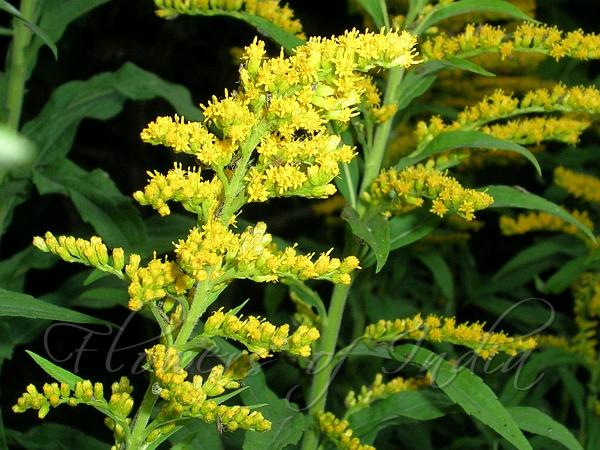|
| Common Goldenrod |
|

|

| File size | 273046 |
| Original date | 6/19/05 6:26 PM |
| Resolution | 2048 x 1536 |
| Flash | Flash fired, auto |
| Focal length | 9.3mm |
| Exposure time | 1/60s |
| Aperture | 5.9 |
| Focus Distance | |
| Metering Mode | Partial |
| Camera make | NIKON |
| Camera model | E3700 |
| Sensor type |
|
|
|
Photo: |
Botanical name: Solidago canadensis Family: Asteraceae (Sunflower family)
Goldenrod is a very common wildflower of America. It occurs
in many habitats, including waste areas, meadows, and on the margins of
forests. Goldenrod is cultivated in cooler regions, and used in floral
arrangements. The color burst of golden yellow in late summer is dramatic.
Goldenrods are easily recognized by their golden inflorescence with hundreds
of small capitula, but some are spike-like and other have auxiliary racemes.
They have slender stems, usually hairless but S. canadensis shows hairs on the
upper stem. They can grow to a length between 60 cm and 1.5 m.
Their alternate leaves are linear to lanceolate. Their margins are usually
finely to sharply serrated.
It is widely believed that Goldenrod causes hayfever. It blooms at about the
same time as ragweed. Because Goldenrod's flowers are quite noticeable, it
gets the blame instead of the less conspicuous ragweed.
Common Goldenrod is native to North America, but widely naturalized
worldwide, including India.
Folklore: There is an old legend that relates goldenrods to asters. Two young girls talks about what they would like to do when they grew up. One, who had golden hair, said she wanted to do something that would make people happy. The other, with blue eyes, said that she wanted to be with her golden-haired friend. The two girls met and told a wise old lady of their dreams. The old lady gave the girls some magic corn cake. After eating the cake, the girls disappeared. The next day, two new kinds of flowers appeared where the girls had walked: Asters and Goldenrods
Folklore: There is an old legend that relates goldenrods to asters. Two young girls talks about what they would like to do when they grew up. One, who had golden hair, said she wanted to do something that would make people happy. The other, with blue eyes, said that she wanted to be with her golden-haired friend. The two girls met and told a wise old lady of their dreams. The old lady gave the girls some magic corn cake. After eating the cake, the girls disappeared. The next day, two new kinds of flowers appeared where the girls had walked: Asters and Goldenrods
| Identification credit: Nandan Kalbag | Photographs from Nainital and Bangalore. |
• Is this flower misidentified? If yes,